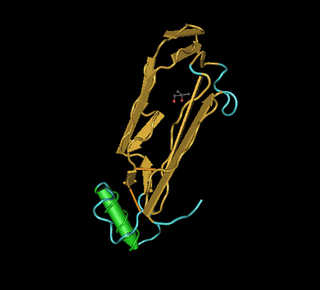Growth differentiation factor 6 (GDF6) is a protein that in humans is encoded by the GDF6 gene. [5]
Growth differentiation factor 6 (GDF6) is a protein that in humans is encoded by the GDF6 gene. [5]
GDF6 belongs to the transforming growth factor beta superfamily and may regulate patterning of the ectoderm by interacting with bone morphogenetic proteins, [6] and control eye development. [7] [8]
Growth differentiation factor 6 (GDF6) is a regulatory protein associated with growth and differentiation of developing embryos. GDF6 is encoded by the GDF6 gene. It is a member the transforming growth factor beta superfamily which is a group of proteins involved in early regulation of cell growth and development. GDF6 has been shown to play an important role in the patterning of the epidermis [9] and bone and joint formation. [10] GDF6 induces genes related to the development of the epidermis and can bind directly to noggin, a gene that controls neural development, to block its effect. [9] GDF6 interacts with bone morphogenetic proteins (BMPs) to form heterodimers that may work to regulate neural induction and patterning in developing embryos. [9] By developing a GDF6 “knockout” model, scientists repressed expression of GDF6 in developing mice embryos. Through this experiment, the scientists were able to directly link GDF6 with several skull and vertebral joint disorders, such as scoliosis and chondrodysplasia, Grebe type. [10]

Growth/differentiation factor 9 is a protein that in humans is encoded by the GDF9 gene.

Noggin, also known as NOG, is a protein that is involved in the development of many body tissues, including nerve tissue, muscles, and bones. In humans, noggin is encoded by the NOG gene. The amino acid sequence of human noggin is highly homologous to that of rat, mouse, and Xenopus.

Bone morphogenetic protein 2 or BMP-2 belongs to the TGF-β superfamily of proteins.

Bone morphogenetic protein 4 is a protein that in humans is encoded by BMP4 gene. BMP4 is found on chromosome 14q22-q23.

Bone morphogenetic protein 10 (BMP10) is a protein that in humans is encoded by the BMP10 gene.

Bone morphogenetic protein 8B is a protein that in humans is encoded by the BMP8B gene.

Bone morphogenetic protein 6 is a protein that in humans is encoded by the BMP6 gene.

Bone morphogenetic protein 5 is a protein that in humans is encoded by the BMP5 gene.

Bone morphogenetic protein 1, also known as BMP1, is a protein which in humans is encoded by the BMP1 gene. There are seven isoforms of the protein created by alternate splicing.

Bone morphogenetic protein 3, also known as osteogenin, is a protein in humans that is encoded by the BMP3 gene.
The transforming growth factor beta (TGFB) signaling pathway is involved in many cellular processes in both the adult organism and the developing embryo including cell growth, cell differentiation, cell migration, apoptosis, cellular homeostasis and other cellular functions. The TGFB signaling pathways are conserved. In spite of the wide range of cellular processes that the TGFβ signaling pathway regulates, the process is relatively simple. TGFβ superfamily ligands bind to a type II receptor, which recruits and phosphorylates a type I receptor. The type I receptor then phosphorylates receptor-regulated SMADs (R-SMADs) which can now bind the coSMAD SMAD4. R-SMAD/coSMAD complexes accumulate in the nucleus where they act as transcription factors and participate in the regulation of target gene expression.

Bone morphogenetic protein receptor type II or BMPR2 is a serine/threonine receptor kinase encoded by the BMPR2 gene. It binds bone morphogenetic proteins, members of the TGF beta superfamily of ligands, which are involved in paracrine signaling. BMPs are involved in a host of cellular functions including osteogenesis, cell growth and cell differentiation. Signaling in the BMP pathway begins with the binding of a BMP to the type II receptor. This causes the recruitment of a BMP type I receptor, which the type II receptor phosphorylates. The type I receptor phosphorylates an R-SMAD, a transcriptional regulator.

The bone morphogenetic protein receptor, type IA also known as BMPR1A is a protein which in humans is encoded by the BMPR1A gene. BMPR1A has also been designated as CD292.

Transforming growth factor-beta 2 (TGF-β2) is a secreted protein known as a cytokine that performs many cellular functions and has a vital role during embryonic development. It is an extracellular glycosylated protein. It is known to suppress the effects of interleukin dependent T-cell tumors. There are two named isoforms of this protein, created by alternative splicing of the same gene.
Growth differentiation factors (GDFs) are a subfamily of proteins belonging to the transforming growth factor beta superfamily that have functions predominantly in development.

Growth differentiation factor-3 (GDF3), also known as Vg-related gene 2 (Vgr-2) is protein that in humans is encoded by the GDF3 gene. GDF3 belongs to the transforming growth factor beta (TGF-β) superfamily. It has high similarity to other TGF-β superfamily members including Vg1 and GDF1.

Growth/differentiation factor 5 is a protein that in humans is encoded by the GDF5 gene.

Growth differentiation factor 7 (GDF7) is a protein that in humans is encoded by the GDF7 gene.

Growth differentiation factor 10 (GDF10) also known as bone morphogenetic protein 3B (BMP-3B) is a protein that in humans is encoded by the GDF10 gene.

Bone morphogenetic protein receptor type-1B also known as CDw293 is a protein that in humans is encoded by the BMPR1B gene.